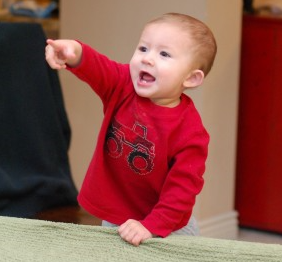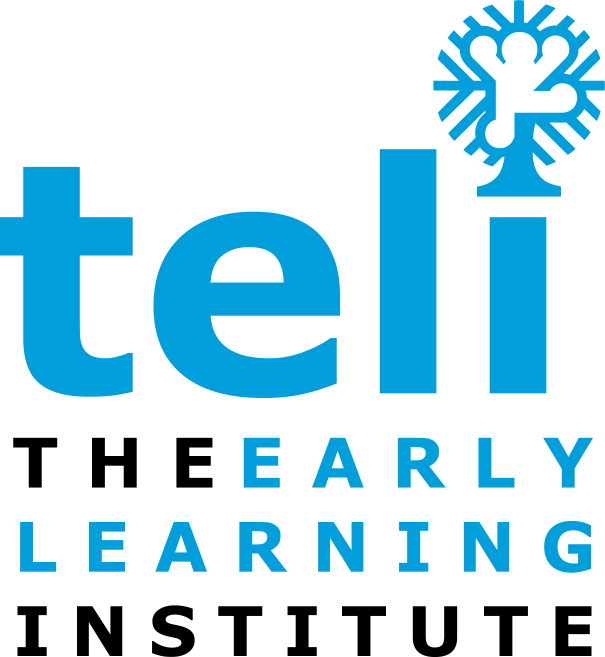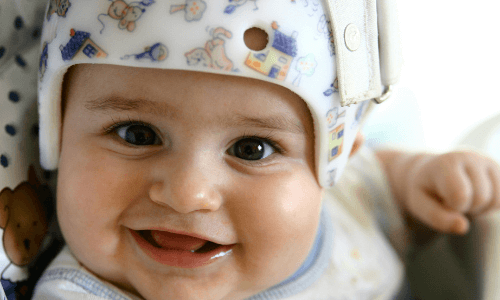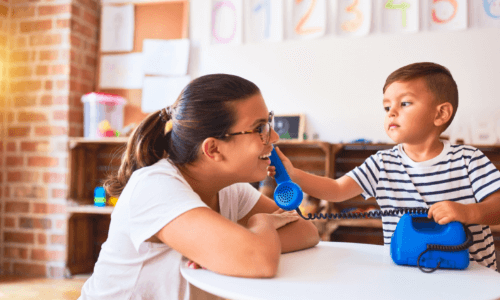 Do gestures boost language development in children?
Do gestures boost language development in children?
When your child points or holds their arms out to be picked up, these gestures are the important beginnings of language development. “Gestures are a significant step as a child begins to interact and communicate with others,” notes Kristi Keele, Pediatric Speech Language Pathologist at teli. “There is a strong link between a child’s early use of gestures and a their ability to reach communication milestones.”
Through her work in Early intervention, Kristi has frequently heard an incorrect myth about a child’s use of gestures early in their language development. “Often parents are concerned that the use of gestures is preventing their child from using words. I share with parents that instead they should encourage their child’s use of gestures. They are a vital part of the child’s beginning to develop their language skills as they eventually pair words with those gestures,” says Kristi.
When should my child begin to use gestures?
The use of gestures may begin to emerge between 9 to 12 months. A child may hold up an object to show you or point to an object to express what they want. “Opening and closing their hand repeatedly to receive, is their way of interacting and communicating that they want something,” notes Kristi. “A child may begin to clap their hands to show pride or excitement, raise their hand to wave bye bye”. By 18 months of age, a child can begin to combine gestures and words. “So the wave is accompanied by the words “bye bye” and a clap with an expressive “Yay!”,” notes Kristi.
How can I help my child begin to use gestures to develop speech?
Whether you realize it or not, as adults we use non-verbal gestures frequently and your child can learn these gestures from you. Children learn through listening, observing, and imitating the world around them. You can play, talk, gesture, sing, laugh and enjoy each other by incorporating the following gestures into your child’s every day activities.
- Sing songs such as “The Wheels on the Bus” that involve hand motions or “Head, Shoulders, Knees and Toes” that begin to help your child learn their body parts.
- Model “arms up” as an alternative to screaming to be lifted.
- Shake your head and pair with the word “No”.
- Play peekaboo with your child, covering your eyes and helping them do the same.
- Assist them with your hand over theirs to point to a book or toy.
- Use a word and a gesture at the same time to reinforce the meaning.
What is the impact of the use of gestures for language development in children?
A child’s use of gestures has been linked with some very encouraging progress in communication and language development. “I like to share with parents that there is a great deal of research that suggest gestures can accelerate your child’s communication skills,” explains Kristi. Some of the impacts seen include:
- A child who uses more gestures tends to develop a larger vocabulary long term.
- A child who points to or shows an object is more likely to learn the word more quickly than a child who does not use gestures.
- A child will combine gestures with words before they combine words together.
- A child who has used gestures will be more able to construct sentences earlier.
What should I do if my child is not using gestures?
If you notice your child does not use gestures, lacks interaction with others or is not using words, Early Intervention can help. While each child develops at their own pace, you may want to discuss your child’s progress with your health professional and consider getting help through Early Intervention. As Kristi can attest, “I have worked with numerous children and their families to understand their communication challenges and develop the appropriate speech therapy to help families address the issues and achieve some great progress.”


